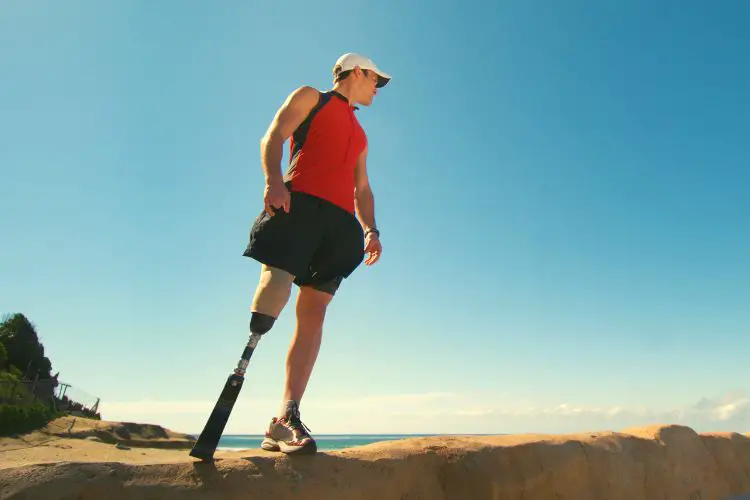Prosthetics and artificial limbs can be a life changer for people who have congenital deformities, have suffered an injury or accident or who have lost limbs due to illness. However, since the needs between patients can vary so greatly, there needs to be several types of prosthetics to meet these.
There are four different types of prosthetics. These are transfemoral, transradial, transhumeral and transtibial. On top of this, there are some other prosthetics that are worth mentioning and in this guide, I’ll be talking about how each of these are used.
The Four Main Types Of Prosthetics
When it comes to prosthetic limbs, there are four main types. Which you will need will depend on where the amputation is. You have two choices for the upper limbs and two for the lower limbs.
Transfemoral
Transfemoral prosthetics are among some of the most challenging out of all the different types. These prosthetics are designed for people who are missing or have had an amputation above the knee joint.
Using one of these prosthetics allows for natural movement since the artificial knee is controlled by the movement of the user’s hip. This means that the prosthesis will only be as strong as the strength that’s in the residual limb.
When wearing a transfemoral limb, you must make sure that the socket fit is spot on otherwise the limb will not be stable and your level of comfort will be seriously disrupted.
Transtibial
Transtibial prosthetics are used by patients who have suffered an amputation below the knee joint. The benefit of these limbs is that the user still has function of the knee so movement is generally a lot easier.
The main use of a transtibial prosthesis is to improve balance and stability as well as allowing the user to distribute weight more evenly as they move around. However, if you are fitted with this type of prosthetic, you will need to go through a period of rehabilitation in order to learn how to walk since while the limb will have an artificial foot, this typically doesn’t move.
Transhumeral
Transhumeral prosthetics are used for patients who have lost part of their arm below the shoulder but above the elbow. Compared to the other type of upper body prosthesis, the transradial limb, this one is slightly more complicated. This is due to the fact that there is no elbow so it’s more difficult to move.
Also keep in mind that the transhumeral prosthesis will either be passive or active. With active limbs, there are myoelectric sensors that aid in movement.
Transradial
The final of the four types of prosthetics is the transradial which is given to people who have lost part of their upper limb below the elbow. These normally come in passive forms and are largely used for their cosmetic value above functionality.
However, there are some active transradial prosthetics which are operated using a cable system. This allows the user complete manual control over the limb through the addition of a myoelectric implant. This implant picks up on muscle movement and mimics this within the prosthesis.
What Are The Other Types Of Prosthetics?
While the above are the main types of prosthetics used for people who have lost or were born without a limb, there are other types. Which you’ll have will depend on your needs which may determine whether you need an active or passive device as well as taking budget into consideration.
There are artificial feet and hands although these can be difficult to make since there is so much variation in terms of injury including missing fingers and hand disfiguration. Moreover, you may not be suitable for this type of prosthesis and this is something you’ll need to discuss with your medical professional.
If you have lost an arm at the shoulder then there are prosthetics that attach to what is left of the joint using a harness. These prosthetics are powered using your body in a very similar manner to the transhumeral prosthesis. Your ‘good’ shoulder will be used to determine how the other shoulder should move.
In some cases, you may not need a functional prosthesis but something that purely has cosmetic value. This may include artificial fingers, nose, eyes and other body parts. With the modern technology available, these prosthetics can look very realistic and can improve confidence for people with disfigurements or who have lost parts of their body.
How Do You Choose Prosthetics?
When it comes to choosing a prosthesis, you will be assisted by a team of medical professionals who will help you find the right equipment for your needs. There will be several factors that are taken into account including where the amputation has taken place and what the condition of the remaining limb is. For example, was the amputation performed above or below the knee or elbow joint and what strength do you have in the remaining limb?
On top of this, your medical team will assess your level of activity which is important when choosing a prosthetic leg. They’ll also think about any individual needs and what your goals are in terms of regaining function and mobility.
You will work closely with someone called a prosthetist who will begin assessing your needs soon after the amputation has taken place. However, you won’t be fitted for the artificial limb until your wound has healed and any associated swelling is reduced.
The fitting will include several things including the following:
- Measuring the opposite limb and your stump.
- Fitting a silicone liner.
- Creating a plaster mould of the stump.
- Making a socket.
- Creating both plastic and metal parts of the prosthesis.
- Attaching a shaft.
- Making proper alignments to the artificial limb.
Once the limb has been fitted and you are well and comfortable, you will be able to start practising using the limb. Normally, this will happen within a few weeks after the surgery.
Conclusion
For anyone who has suffered an accident or illness that has resulted in the amputation of a limb, this can be an incredibly concerning time. However, medical and technological advances mean that there are a number of prosthetics out there that can help you with both cosmetics and functionality.
There are four main types of prosthetics and which you need will depend on the location of the amputation as well as other factors. It’s important to work closely with your medical team to find the right fit and learn how to use your new limb.

